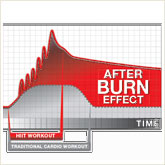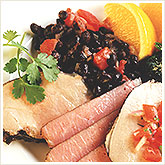The Science Behind
TurboFire By Steve Edwards
From Team Beachbody - Click here for resources, tools and
information to help you to reach your health, fitness and positive lifestyle
goals!
Essentially, the entire TurboFire program
has a singular focus: that getting fit can be fun, and that eating healthy
doesn't need to be a complex task. And while there's a lot of science behind
what you'll see as you follow along, our goal was to make it as simple as the
original Beachbody® tagline:
Just Push Play.
Whenever you have one successful workout
program, it's always hard to decide what to do next. When you have three, like
Turbo
Jam®,
Turbo Kick®,
and
ChaLEAN
Extreme®
creator Chalene Johnson does, it can seem like an especially daunting task. But
when Johnson's Fat Blaster workout (part of the
Turbo
Jam® Fat
Burning Elite program) became a serendipitous hit, we knew it was time
for Chalene to take things to the next level. That's how the idea for
TurboFire® was born. The
goal was to create a next-level fitness program that could be done by anyone
and was easy to follow. Here's how we did it.

What is HIIT?
TurboFire is based around a concept called
High Intensity Interval Training, or HIIT. HIIT has been somewhat popular since
the '90s, when a study suggested that you could burn up to 9 times more body
fat using short but very high-intensity intervals than you could using
old-school steady-state aerobic training. HIIT's popularity had been cultish,
mainly because HIIT training had two perceived negatives associated with it.
First, it's hard; as in full-bore, maxed-out cross-eyed hard. (The Tabata study
from '96 forced subjects to 170% of VO2 max, or the maximum capacity for the
body to transport and use oxygen during incremental exercise.) Second, it can
only be effective when done in short cycles. But Chalene was intrigued with
HIIT's time-efficient structure, which promised great results, so we decided to
see if we could create a training program based around it.
The AfterBurn Effect
Our decision to focus on HIIT wasn't based
on just one study. Additional studies have showed similar results, using
variations of the HIIT protocol. A 2001 study concluded that HIIT training
increases the resting metabolic rate (RMR) for the 24 hours following a workout
due to excess post-exercise oxygen consumption, which explains how a short
interval workout can have a longer-lasting effect on body composition change
than a much longer cardio session.
We termed this phenomenon the AfterBurn
Effect and began assembling a series of workouts that could maximize HIIT
across many training platforms. Increases in post-exercise oxygen consumption
are not unique to HIIT. No other style of training has HIIT's peak numbers, but
they can be done for longer periods of time. There is science behind the saying
"For every action, there is a reaction."
 All that intense HIIT training comes at a cost;
the body breaks down quickly and it can't be sustained for very long. All that intense HIIT training comes at a cost;
the body breaks down quickly and it can't be sustained for very long.
Numerous studies were on the same page in
showing that fitness gains made with HIIT training begin to plateau sometime
after the third week. Therefore, the key to creating a fitness program
using the HIIT modality required us to figure out how to either get the body to
recover for another round of HIIT training as quickly as possible, or look at
other training modalities that could work in conjunction with HIIT that also
yielded results.
The Periodizational Approach
In basic terms, periodizational training
means finding a way to alter training over time to maximize results; sort of
like basic cross-training, but with a more well-defined plan. If you're
familiar with Beachbody's fitness programs, you've seen this before. All our
programs have a schedule that changes over time. The two factors that control
how much change occurs are time and intensity. Essentially, over time everyone
should alter their approach to training, and the fitter you are, the more your
approach needs to change, to continually cause something called the adaptation
response. For those of you who've done
P90X®, the
TurboFire schedule should look familiar.
But TurboFire, as Chalene says, "is not P90X
for girls." It's a HIIT-focused training program, where all the other training
is designed to prepare you to get the best results possible during your HIIT
training phases. And while both P90X and TurboFire have a somewhat complex
periodizational structure, their schedules are quite different. TurboFire
combines both of the philosophies you'll hear Chalene espouse in her other
programs, Turbo Jam and ChaLEAN Extreme.
Muscle Burns Fat®
The tagline from ChaLEAN Extreme, Muscle
Burns Fat®,
doesn't get chucked out the window just because we created some HIIT routines.
The physiological principle that adding muscle to your frame increases your
metabolism and leads to changes in body composition is valid, and you'll find
that resistance work is a major component of TurboFire.
In ChaLEAN Extreme, you'll often hear
Chalene say you should do resistance training three times per week for the rest
of your life. It's not just talk, and TurboFire holds you to it. In fact, in an
homage to the P90X tagline, Muscle Confusion™, as part of the TurboFire
program, you'll receive a schedule for a hybrid program that combines ChaLEAN
Extreme and TurboFire. When you combine the two programs, you get a
periodizational schedule that'll keep challenging your body's adaptation
response for nearly a year!
Advanced Cardio Conditioning
 TurboFire, in fact, is not as much of a HIIT program as
it is a Chalene program. Her workouts are unique, and TurboFire is very much an
extension of her first Beachbody program, Turbo Jam, which was a home version
of her health club training class, Turbo Kick. She termed her first vision of
TurboFire "the next level of Turbo Kick," and that's pretty much what we've got
here. The program has the look and feel of being in an exercise class at the
gym—Chalene's preferred environment. TurboFire, in fact, is not as much of a HIIT program as
it is a Chalene program. Her workouts are unique, and TurboFire is very much an
extension of her first Beachbody program, Turbo Jam, which was a home version
of her health club training class, Turbo Kick. She termed her first vision of
TurboFire "the next level of Turbo Kick," and that's pretty much what we've got
here. The program has the look and feel of being in an exercise class at the
gym—Chalene's preferred environment.
Chalene likes the class environment because
"it's fun and provides motivation." But there's more than fun at the root of
her classes. Cardio is an umbrella term that covers a lot of different styles
of training, from easy aerobic to intense HIIT. No matter where between these
extremes your workout falls, you're going to be targeting different human
energy systems that have different physiological benefits. For the TurboFire
system, Chalene created different cardio classes to make sure each of these
energy systems were being targeted, to achieve an effect she calls Cardio
Confusion, a play on words referencing P90X's Muscle Confusion.
Cardio Confusion is more than a slogan. The
cardio phases of the TurboFire program combine different styles of interval
training with recovery-oriented aerobic training to create a steady growth
curve in your fitness levels. This accelerates your body's ability to get ready
for your next round of HIIT, but it also takes advantage of the AfterBurn
Effect by targeting different energy systems.
Recovery
Targeted recovery is not a by-product of
TurboFire, but an essential part of the program. That you only get stronger at
rest is a gym cliché that, as many do, holds a lot of truth.
Active recovery helps your body grow strong much more quickly than does rest
alone. All high-level training programs work better if they contain targeted
rest and recovery phases. During these periods, you target the body's aerobic
system, stabilizer muscles, and use techniques, which stretches out overworked
muscle fibers and heals connective tissue microtrauma.
A program for one. A program for all.
It's often difficult to find one fitness
program that would work for everyone, and it's generally not best to recommend
that everyone do the same program, rather than steering each person toward the
program that best fits their needs. Reality, though, has taught us that people
often want to do what inspires them, whether it fits their ability level or
not. Beachbody's high-level programs P90X and
Insanity® are meant to
be "graduate" programs only; each comes with a fitness test that, if you can't
complete it, recommends you do a lower-level program first instead. While our
beginning-level customers should pay attention to this advice, and would
usually get better results with an easier program, we've learned that they
don't always do what we recommend.
With TurboFire, however, we've done our best
to allow nearly anyone to attempt the program safely. In fact, we included a
2-month preparatory schedule for anyone who thinks they may not be ready for
the rigors of HIIT training. Not only that, every move in the program comes
with a modified version that almost anyone should be able to follow.
Furthermore, Chalene recognized that some men can be rhythm-challenged, so she
purposely made the choreography a lot easier to follow than it is in Turbo Jam
and her health club classes.
Diet
 The final element of the program is diet, another element
where TurboFire has evolved beyond other Beachbody programs. TurboFire has gone
in the opposite direction from P90X, which has a phased eating plan that some
of our customers have found to be complex. Instead, TurboFire's diet has
expanded on the Beachbody Step by Step Nutrition Guide and tried to give you a
variety of different ways to alter your eating habits, with the same end
purpose as our other plans: a balanced diet that fuels exercise recovery. The final element of the program is diet, another element
where TurboFire has evolved beyond other Beachbody programs. TurboFire has gone
in the opposite direction from P90X, which has a phased eating plan that some
of our customers have found to be complex. Instead, TurboFire's diet has
expanded on the Beachbody Step by Step Nutrition Guide and tried to give you a
variety of different ways to alter your eating habits, with the same end
purpose as our other plans: a balanced diet that fuels exercise recovery.
- Coffee, V.G. and J.A. Hawley. The
molecular bases of training adaptation. Sports Med. 37:737-763, 2007.
- Gibala, Martin J; Jonathan P.
Little, Martin van Essen, Geoffrey P. Wilkin, Kirsten A. Burgomaster, Adeel
Safdar, Sandeep Raha and Mark A. Tarnopolsky (September 15 2006). "Short-term
sprint interval versus traditional endurance training: similar initial
adaptations in human skeletal muscle and exercise performance". J Physiol 575
(3): 901â911.
- King, Jeffrey W. A Comparison of
the Effects of Interval Training vs. Continuous Training on Weight Loss and
Body Composition in Obese Pre-Menopausal Women: A thesis presented to the
faculty of the Department of Physical Education, Exercise, and Sports Sciences,
East Tennessee State University; 2001.
- Little, Jonathan P; Adeel S.
Safdar, Geoffrey P. Wilkin, Mark A. Tarnopolsky, and Martin J. Gibala (2009).
"A practical model of low-volume high-intensity interval training induces
mitochondrial biogenesis in human skeletal muscle: potential mechanisms". J
Physiol.
- Melby, C., C. Scholl, G. Edwards,
and R. Bullough. Effect of acute resistance exercise on postexercise energy
expenditure and resting metabolic rate. J. Appl. Physiol. 75:1847-1853,
1993.
- Tabata I, K. Nishimura, M. Kouzaki,
et al. (1996). "Effects of moderate-intensity endurance and high-intensity
intermittent training on anaerobic capacity and VO2max". Med Sci Sports Exerc
28 (10): 1327â30.
- Tremblay, A., J. Despros, C.
Leblanc, C.L. Craig, B. Ferris, T. Stephens, and C. Bouchard. Effect of
intensity of physical activity on body fatness and fat distribution. Am J.
Clin. Nutr. 51:153-157, 1990.
- Tremblay A, JA Simoneau, C Bouchard
(1994). "Impact of exercise intensity on body fatness and skeletal muscle
metabolism". Metab. Clin. Exp. 43 (7): 814â8.
|
|